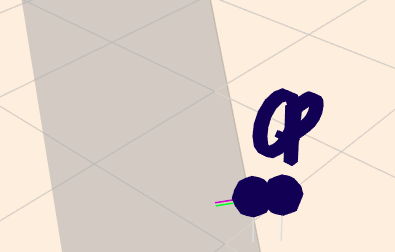Hallo,
Die Ebenengleichung, die die Wand beschreibt, lautet $$E: \space \begin{pmatrix} 5\\ 5\\ 1 \end{pmatrix}x - 60 = 0$$bringe das in die Hessesche Normalform, so dass die Länge des Normalenvektors \(=1\) ist:$$\frac 1{\sqrt{51}} \left( \begin{pmatrix} 5\\ 5\\ 1 \end{pmatrix}x - 60 \right) = 0$$Nun ist ja nur nach den Abständen der Sensoren zur Wand gefragt. Die Positionen der Sensoren \(P\) und \(Q\) sind gegeben:$$P = \begin{pmatrix} 6,2\\ 6,2 \\ 0,3 \end{pmatrix}, \quad Q = \begin{pmatrix} 6,1\\6,1\\ 0,3 \end{pmatrix}$$und zur Berechnung des Abstandes setze diese einfach für \(x\) in die Ebenengleichung ein$$e(P) = \frac 1{\sqrt{51}} \left( 62,3 - 60 \right) \approx 0,322 \gt 0,3\\ e(Q) = \frac 1{\sqrt{51}} \left( 61,3 - 60 \right) \approx 0,182 \lt 0,3 $$Die Darstellung im Geoknecht3D zeigt das Szenario auf Grund der kleinen Abstände etwas unschön. Die grüne Strecke ist der Abstand von \(P\) und die rote der von \(Q\)

(klick auf das Bild)
zu B) Stelle eine Gerade auf, die durch \(P\) und \(Q\) verläuft:$$g: \space x = P + t(Q-P) = \begin{pmatrix} 6,2\\ 6,2 \\ 0,3 \end{pmatrix} + t \begin{pmatrix} -0,1\\-0,1\\ 0 \end{pmatrix}$$und setze diese für das \(x\) in die Ebenengleichung ein, mit der zusätzlich Forderung, dass der Abstand \(=0,3\) sein soll:$$\frac 1{\sqrt{51}} \left( \begin{pmatrix} 5\\ 5\\ 1 \end{pmatrix}\left(\begin{pmatrix} 6,2\\ 6,2 \\ 0,3 \end{pmatrix} + t \begin{pmatrix} -0,1\\-0,1\\ 0 \end{pmatrix} \right) - 60 \right) = 0,3 \\ 62,3 - t - 60 = 0,3 \cdot \sqrt{51} \\ t = 2,3 - 0,3 \cdot \sqrt{51} \approx 0,158$$setzte das \(t\) oben in die Geradengleichung ein und Du bekommst \(r=g(t)\).